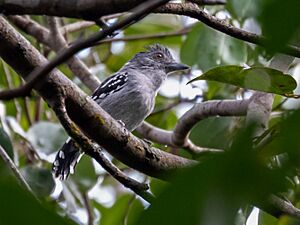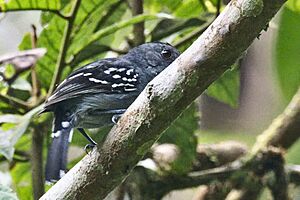Northern slaty antshrike facts for kids
Quick facts for kids Northern slaty antshrike |
|
|---|---|
 |
|
| Conservation status | |
| Scientific classification | |
| Genus: |
Thamnophilus
|
| Species: |
punctatus
|
 |
|
| Synonyms | |
|
Thamnophilus punctatus punctatus |
|
The northern slaty antshrike (Thamnophilus punctatus) is a cool bird found in South America. It's part of a group of birds called "typical antbirds." You can find it in countries like Brazil, Colombia, Ecuador, and Venezuela.
Contents
What's in a Name?
The northern slaty antshrike's scientific name is Thamnophilus punctatus. This name used to cover a much larger group of birds. Scientists later found that what they thought was one species was actually six different ones! To avoid confusion, the bird we know today was given the name "northern slaty antshrike."
This bird has four different types, called subspecies:
- T. p. interpositus
- T. p. punctatus
- T. p. leucogaster
- T. p. huallagae
Some scientists group the first two as the "Guianan" type. The last two are sometimes called the "Peruvian" type.
What Does It Look Like?
The northern slaty antshrike is about 13 to 15 centimeters (5 to 6 inches) long. It weighs around 16 to 18 grams (about half an ounce). These birds have strong bills with a hook, a bit like a shrike bird.
Males and females of this species look quite different. This is called sexual dimorphism.
Male and Female Differences
Adult males of the main type (T. p. punctatus) have a gray forehead and a black top of the head. Their back is gray with some black tips. They have a hidden white patch on their back. Their face is gray. Their wings are black with white spots and edges. Their tail is black with white spots and tips. Their belly is usually slaty gray, sometimes with a white center.
Adult females have a reddish-brown top of the head. Their upper body is yellowish olive-brown. Their wings are dark brown with white spots. Their tail is reddish yellow-brown with white spots. Their belly is light buffy olive, becoming whiter on the throat.
Subspecies Colors
- Males of T. p. interpositus have a black forehead, head, and upper body. Their underparts are dark gray. Females are a darker clay color.
- Males of T. p. leucogaster have a mostly black forehead. They have many white spots on their black head. Their upper body is dark gray with few black spots. Their underparts are gray with a white belly center. Females have a brown back and mostly white underparts.
- Males of T. p. huallagae have a black forehead. They have many white spots on their black head. Their upper and lower parts are darker gray than the main type. Females have more olive-colored underparts.
Where Do They Live?
The northern slaty antshrike lives in different areas. Each subspecies has its own separate home range.
The main subspecies (T. p. punctatus) lives in the largest area. You can find it in eastern and southern Venezuela. It also lives across the Guianas and in Brazil, east of the Negro River and north of the Amazon River.
- T. p. interpositus lives on the east side of the Andes mountains. This is from western Venezuela south into Colombia.
- T. p. leucogaster is found in southern Ecuador and northern Peru. It lives near the Marañón River.
- T. p. huallagae lives only in the Huallaga River area in northern Peru.
What Kind of Homes Do They Like?
These birds live in many types of forests and wooded areas. They prefer to stay in the lower to middle parts of the trees.
In Brazil and the Guianas, they live in forests with white-sand soil. They also like open woodlands and older secondary forest (forest that has grown back after being cut down). They live from sea level up to about 1,000 meters (3,300 feet) high.
In Colombia, they like the edges of different forest types below 600 meters (2,000 feet). In Ecuador and Peru, they live in drier woodlands. In Ecuador, they are found at about 650 meters (2,100 feet). In Peru, they can be found up to 1,200 meters (3,900 feet). In Venezuela, they live up to 1,500 meters (4,900 feet) high. They prefer the edges of mature forests there.
How Do They Behave?
Movement
The northern slaty antshrike usually stays in the same area all year round. It does not migrate.
What Do They Eat?
This bird mainly eats insects and other small creatures like spiders. It usually looks for food alone or in pairs. Sometimes, it joins groups of different bird species that are feeding together.
They mostly search for food in the lower and middle parts of the trees. They usually stay between 1 and 6 meters (3 to 20 feet) off the ground. But they can go as high as 12 meters (39 feet). They find food by picking prey off leaves, branches, and vines. They have also been seen flipping over leaves on the ground. Sometimes, they follow army ants to catch insects that the ants stir up.
Reproduction and Life Cycle
Scientists are still learning about when and how the northern slaty antshrike breeds. It seems to vary depending on where they live. Nests have been found in Brazil in August and from October to December. They have also been found in French Guiana in August.
Their nest is shaped like a cup. It's made from shredded plant fibers and lined with fine grass. Sometimes, they add green moss to the outside. The nest hangs from a branch fork low to the ground. A female usually lays two eggs. We don't know how long the eggs take to hatch or how long it takes for the young birds to leave the nest.
What Do They Sound Like?
The northern slaty antshrike's song is a series of notes that get faster and shorter. It starts with slow, clear notes and ends with a fast trill. The trill often sounds higher in pitch. The speed of the song changes among the different subspecies.
People have described its song as "oank, oank, ank, ank, ank, ank-ank-ankank" or "kah kah kah-kah-kah'ka'ka'ka'ka'kr." Its calls include a short "caw," a longer "caw," and a harsh, sudden note.
Status and Conservation
The IUCN (International Union for Conservation of Nature) says the northern slaty antshrike is of "Least Concern." This means it's not currently in danger of disappearing. We don't know exactly how many of these birds there are or if their numbers are growing or shrinking. No big threats have been found for the species as a whole.
The main subspecies has a very large home range. It is thought to be fairly common. However, two of the subspecies (T. p. leucogaster and T. p. huallagae) live in very small areas. Their dry forest homes are being changed by farming. This means these two types of northern slaty antshrike might be at risk. The T. p. huallagae subspecies has a very small range, and its habitat is broken into small pieces.



